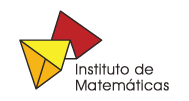Coloquio Oaxaqueño de Matemáticas, mayo 2022
Coloquio virtual, IMUNAM - Oaxaca
https://sites.google.com/im.unam.mx/coloquioax/
* Jueves 12 | 13:00 horas
Modelación matemática del estilo musical: Pablo Padilla Longoria, IIMAS - UNAM
Resumen:
El estudio de estilos musicales usando métodos matemáticos permite proporcionar herramientas en la resolución de diversos problemas musicológicos y cognitivos. Discutiremos, entre otros temas:
•Esclarecimiento de autorías de obras musicales.
•Proponer cronologías en la composiciones de un mismo autor.
•Determinar la cercanía estilística de diferentes reconstrucciones de piezas incompletas.
Para ello tomamos ejemplos que van desde la música inglesa renacentista hasta la música del siglo XX.
---------------------------
* Jueves 19 | 13:00 horas
Polyhedra, polytopes and finite simple groups: Dimitri Leemans, Université Libre de Bruxelles
Resumen:
The classification of finite simple groups, achieved in the eighties, is one of the most spectacular achievements in mathematics, combining the efforts of hundreds of researchers. Its proof amounts to roughly 15,000 pages. Current revisions of this result aim to bring back to less than 10,000 pages the proof of this amazing result. Simple groups play in group theory the role of prime numbers in number theory. They are the building blocks of groups as the primes are the building blocks of numbers.
The classification gives 18 infinite families and 26 groups that are called sporadics, the largest one being the Monster or Friendly Giant, a group of order 808,017,424,794,512,875,886,459,904,961,710,757,005,754,368,000,000,000, roughly 8x 10^{53}.
Geometric interpretations of the finite simple groups have been discovered over decades and Jacques Tits' theory of buildings is so far the most unified geometric way of seeing these groups. Only the alternating and the sporadic groups are not covered by Tits' theory.
In this talk, we will focus on polyhedra and polytopes. These very natural geometric objects have been studied for millennia. The most famous ones are probably the five platonic solids, competing with the truncated icosahedron, also known as the buckminsterfullerene.
We will introduce polytopes in an abstract way. We will then focus on two classes of polytopes. Those that have maximum level of symmetry (the regular ones) and those that have all rotational symmetries but no mirror symmetries (the chiral ones).
We will then make the link between these objects and special sets of generators of groups. A regular polytope has an automorphism group generated by involutions. This group is a smooth quotient of a Coxeter group. Similary a chiral polytope has a group generated by elements (not necessarilyinvolutions) and therefore these geometric objects can be classified using their automorphism group.
The finite simple groups that can appear as automorphism groups of regular polytopes have been classified. We will talk briefly about that classification. In the chiral case, this classification is not complete yet. We will explain where we stand nowadays.
The talk will be accessible to a large audience. We do not intend to enter into technical details.
---------------------------
* Jueves 26 | 13:00 horas
La conjetura "optimista" de Lekili y Polishchuk: Gustavo Jasso, Lund University
Resumen:
El propósito de la plática es explicar, omitiendo los detalles técnicos y a grandes razgos, de que trata la conjetura "optimista" de Lekili y Polishchuk sobre categorías de Fukaya asociadas a superficies. Nos enfocaremos en el aspecto algebraico de la conjetura, en particular en la relación entre dichas categorías de Fukaya y la teoría de representaciones de álgebras, así como en ejemplos concretos.

